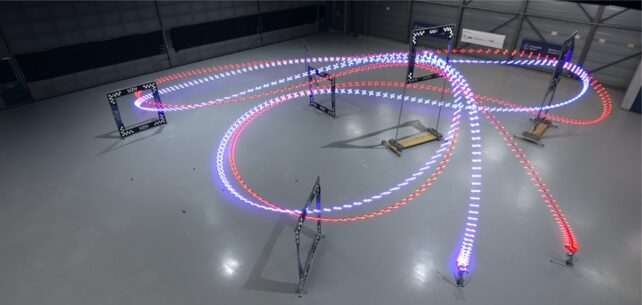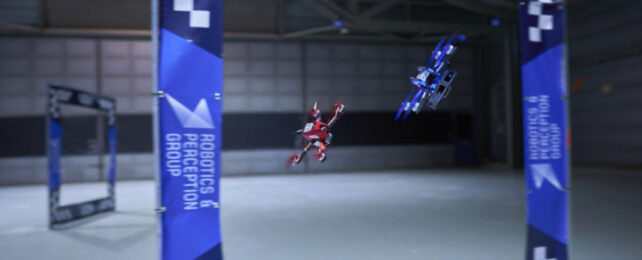The abilities of artificial intelligence (AI) systems are advancing at an astounding rate, nearing or bettering what humans can do in simulations and test environments.
Setting aside the ethical and environmental concerns around AI and those of autonomous drones for a minute, we can marvel at this latest feat: an AI-controlled drone system that beat three professional drone pilots in a series of head-to-head races, winning more often than not.
Swift is the name of the autonomous system, which outmaneuvered the world-champion human pilots in 15 of the 25 races, on a track full of sweeping turns and screeching pivots designed by a professional drone-racing pilot.
The aptly named system combines AI-learning algorithms with a single camera and onboard sensors that detect the drone's surroundings and movement.
It was designed by Elia Kaufmann, a robotics engineer at the University of Zurich, and researchers at Intel Labs who wanted to design a system that didn't rely on inputs from external motion cameras, as previous autonomous racing drones have.
"Reaching the level of professional pilots with an autonomous drone is challenging because the robot needs to fly at its physical limits while estimating its speed and location in the circuit exclusively from onboard sensors," Kaufmann and colleagues write in their paper.
Drone-racing pilots wear headsets that give them a 'first person' view through a camera attached to the drone, which can reach speeds of 100 kilometers per hour.
Likewise, Swift has an onboard camera and an inertial sensor to measure the drone's acceleration and rotation; data which two AI algorithms ingest to triangulate the drone's position relative to the square gates on the obstacle course and to produce control commands accordingly.

Although it lost 40 percent of the races, Swift beat each human pilot multiple times and clocked the fastest recorded race time, half a second faster than the best human time.
"Overall, averaged over the entire track, the autonomous drone achieves the highest average speed, finds the shortest racing line, and manages to maintain the aircraft closer to its actuation limits throughout the race," Kaufmann and colleagues report.
According to Guido de Croon, a robotics researcher at Delft University of Technology in the Netherlands, who penned a commentary about the study, Swift's "true innovation" is the second artificial neural network deployed, which uses deep reinforcement learning.
That means the network mostly learns through trial and error during the training process, applying its learned controls to turbulent real-world vision.
Like the human pilots, who were given a week to practice on the track, Swift was trained in a simulation of the race track, and the deep learning algorithm explored possible paths through the track's seven gates to find faster and faster routes.
With the control commands optimized and mapped out, Swift could then process visual inputs as it raced around the course in a few test runs.
"The small differences that remain between simulation and reality are learnt by a neural network to improve the simulation and refine the system's strategy," de Croon explains.
Swift is certainly not the first drone to navigate physical obstacles, but it does so with remarkable precision.
Last year, researchers launched a swarm of drones equipped with a processing system that allowed them to sense obstacles and navigate their way through a thick bamboo forest.
Plane-shaped, human-controlled drones have also been sent into volcanoes to monitor their activity.
Further developments will be necessary before Swift can take to outdoor arenas with unpredictable conditions, de Croon says.
"Given that drones acquire sensing information more rapidly than do human pilots, who rely on delayed images, [autonomous] drones will no doubt eventually beat humans under these difficult conditions as well," he concludes.
The study has been published in Nature.
